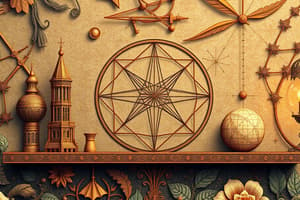Podcast
Questions and Answers
What is the study of shapes, sizes, and positions of objects?
What is the study of shapes, sizes, and positions of objects?
- Algebra
- Number Theory
- Calculus
- Geometry (correct)
What is the study of variables and their relationships?
What is the study of variables and their relationships?
- Arithmetic
- Geometry
- Algebra (correct)
- Combinatorics
What is the collection of unique objects, often represented using curly braces {}?
What is the collection of unique objects, often represented using curly braces {}?
- Graphs
- Probability
- Functions
- Sets (correct)
What is the study of change and motion, including limits, derivatives, and integrals?
What is the study of change and motion, including limits, derivatives, and integrals?
What are logical and systematic arguments used to establish the validity of mathematical statements?
What are logical and systematic arguments used to establish the validity of mathematical statements?
What is the study of counting and arranging objects in different ways?
What is the study of counting and arranging objects in different ways?
Flashcards are hidden until you start studying
Study Notes
Branches of Mathematics
- Arithmetic: Study of numbers and their operations, including addition, subtraction, multiplication, and division.
- Algebra: Study of variables and their relationships, often expressed through the use of symbols, equations, and functions.
- Geometry: Study of shapes, sizes, and positions of objects, including points, lines, angles, and planes.
- Calculus: Study of change and motion, including limits, derivatives, and integrals.
- Number Theory: Study of properties of integers and other whole numbers, including primality, divisibility, and congruences.
- Combinatorics: Study of counting and arranging objects in different ways, including permutations and combinations.
Mathematical Concepts
- Sets: Collections of unique objects, often represented using curly braces {} and described using set operations (union, intersection, difference).
- Functions: Relations between a set of inputs (domain) and a set of possible outputs (range), often represented using variables and equations.
- Graphs: Visual representations of relationships between objects, including nodes, edges, and vertices.
- Probability: Study of chance events and their likelihood of occurrence, including probability distributions and Bayes' theorem.
Mathematical Tools and Techniques
- Proofs: Logical and systematic arguments used to establish the validity of mathematical statements.
- Algorithms: Step-by-step procedures used to solve mathematical problems, including sorting, searching, and calculating.
- Modeling: Use of mathematical equations and formulas to describe real-world phenomena, including population growth, physics, and economics.
- Approximation: Use of numerical methods to estimate solutions to mathematical problems, including interpolation and extrapolation.
Studying That Suits You
Use AI to generate personalized quizzes and flashcards to suit your learning preferences.




